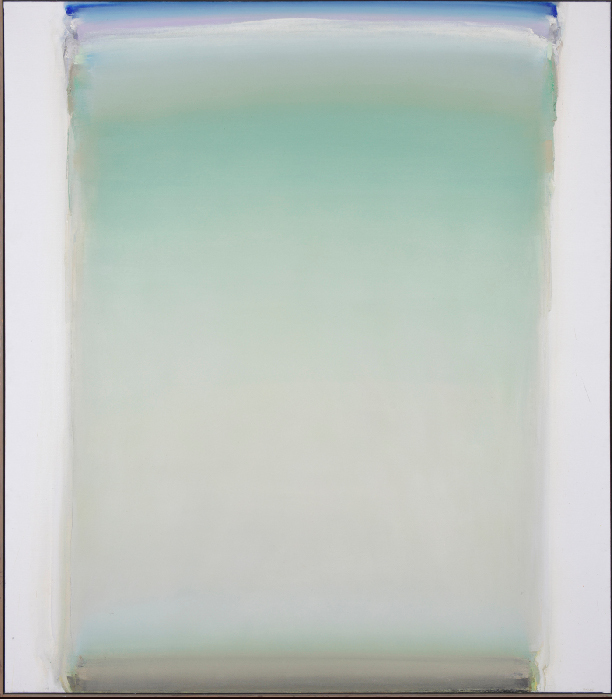Meadow Landscape
Meadow Landscape from 1972 is a quintessential example of Dailey’s enormous oil paintings from the 1970s. It is also a beautiful example of his interest in luminism, which has its roots in the Hudson River School.
Dailey’s skill is in suggesting; he suggests landscapes with the colors and the verticality of his paintings, like Meadow Landscape, that mimic the almost neverending feeling of land and sky. In this painting, we see a vast canvas, nearly the size of a wall in height and the width of a person’s wingspan; it dwarfs the average-sized viewer and imparts that feeling of the Sublime upon the viewer. We feel awe at the size and beauty of the canvas, but a slight fear creeps in as we imagine being overwhelmed by this amount of nature.
The painting is composed of strips of paint that blend into one another and create the distant and blurry illusion of a landscape. The bottom of the canvas is brown, an indication of land or dirt that vertically fades into a green that transitions to a lighter yellow-green, then to a more saturated green, and back to yellow-green. There is a patchy strip of white at the top, implying clouds and then purple and blue fill the small gap above the white at the top of the canva representing the sky. The green takes up most of the canvas as nature takes up so much of our world and feels like it dominates all when one is in it.
The use of yellow mixed with green gives the sensation of light, once again showing his Dailey’s artistic lineage that dates back to Luminism, the Hudson River School, and Romanticism and thus is deeply tied to landscape. Dailey was interested in synesthesia- the multiplicity of sensations something can provide, and his paintings provide that with his use of color and light. One can smell the grass and feel the sun's warmth, but one must be invested in the painting first and insert oneself in it as it is abstract- it does not describe, it implies. And while his paintings are bands of color, they are examples of his experimentation with light to show specific times of day- a practice common in the Renaissance but more popular in the 19th century with Impressionism and Romanticism. Experimenting with light shows skill and attention to nature’s idiosyncrasies and an interest in how different things look depending on the light. Thus, when we look at Meadow Landscape, we can imagine a particular time of day, such as sunset or sunrise, where the sun is bright, but the sky begins to change color.
Meadow Landscape shows us that landscape can be recognized as itself in many different forms and iterations, sometimes, one does not need to suggest anything recognizable or figurative, but the colors themselves imply something we are all familiar with- especially in the Pacific Northwest- nature.

